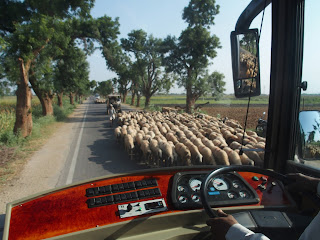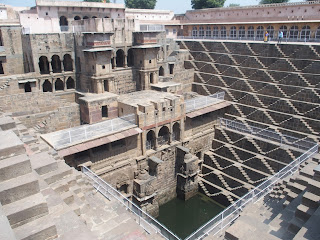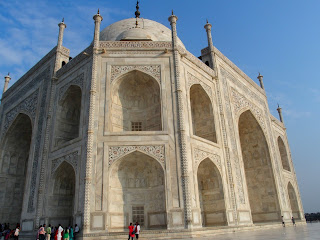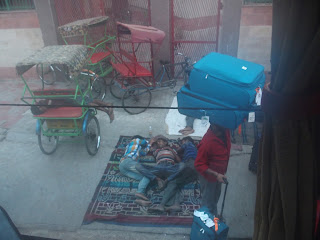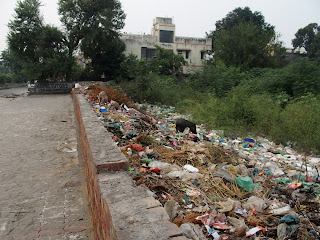On 31 October 2016 we flew to Melbourne to see our new grandson Sean (and his mum & dad of course) and after a few days there in the not too warm Aussie Spring weather, the five of us plus Laura, took two cars on a trip the Grampians National Park. 'Geriwerd' is the aboriginal word for this vast wildreness of sandstone ridges, waterfalls, vertical cliffs and mile after mile of bush.
Above: On the way to Halls Gap in the Grampians, we stop at Beaufort, a town of about 1000 people situated between Ballarat and Ararat. Lovely and warm!
Below: Our spacious cabin, surrounded by trees and birds including the obligatory cockatoos. On our walks to and from Halls Gap we see emus, wallabies and kangaroos galore.
Below: Halls Gap golf course. Put 10 dollars in the honesty box and have a game. Not a luxurious looking club house but a golf course in a truly beautiful setting.
No bunkers, you have to get over the roos instead.
On our walk up to Boronia Peak we spied many different kinds of lizards sunbathing and this echidna having its daily sleep.
Below: Sean on his first trek. Note the Vietnamese hat being worn by his dad.
Nearly there.
The next day we took in the Boroka and Reed lookouts for fantastic views, the Mackenzie Falls (too busy so we did not stay long) and the Zumsteins camping ground where we learned about the visionary Walter Zumstein and his family who lived there over 100 years ago.
After spending a few more days in Melbourne we took a flight to the Sunshine Coast and spent a week in Noosa. Warm sea, cold beer and great food.
Two days before flying back to England Laura and I each did a tandem skydive over Melbourne. The base is at St Kilda beach. The morning was a little cloudy but we had spectacular views of Melbourne and Port Phillip Bay.
There's Laura, front left. She went out 2nd, me 5th.
Monday, December 5, 2016
Sunday, October 9, 2016
India - Taj Mahal & the Golden Temple
New Delhi is endlessly fascinating with well over 18 million people living and often just existing there. It is one of the world's most polluted cities - busy, noisy, bustling with pedestrians, bicycles, rickshaws, autos (aka tuk-tuks) buses, cows, pigs, dogs, mopeds, motor bikes, cars, camels and horses. Drivers hoot endlessly, though nobody appears to shout or get angry despite the lack of order. The highway code seems to be 'go if you see a space'.
A pavement card game.
Some tranquility in the grounds of the Qutb Minar
At the immense Jami Masjid and getting ready for a rickshaw ride around the narrow streets and alleyways of old Delhi.
Our drive to Jaipur (the Pink city) was marred by the coach having a flat tyre. Our excellent driver and his assistant did not have the tools or a suitable replacement tyre to be able to effect a repair. We were marooned by the side of a busy road until a kindly man (below right) driving an empty bus took us to a rest stop where we waited for five hours. Our guide, the immensely likeable Shahju, went to a local 'shop' and came back with cans of 8% Kingfisher. The anesthetic partially mollified us.
The next day dawned bright and hot and we took a short drive out of Jaipur to the Amber Fort. You can walk up or drive in a jeep. We took an elephant. Unfortunately it decided to clear its trunk over us at one point. Aaaah, the joys of India. It must have been the elephant that gave me a cold! Amber Fort is spectacular, as are the views from its walls.
The elephants are off home after their morning's work.
We tried to find the moped with the highest number of passengers. This one has to be in contention for the prize. Dad, Mum and the three children. Helmets are compulsory in Delhi but appear to be optional elsewhere and of course the Sikhs have dispensation not to have to wear them.
Printing by hand in Jaipur. Beautiful fabrics. Guess what? Trish bought a carpet.
Our lovely 'boutique' hotel. The swim before dinner was most refreshing.
My, what long tails you have grandmas...
Off to get sheared.
Abhaneri is known for 'Baoris', aka step wells, which were invented by local people to harvest rain water. These tanks were used as cool places of retreat and as water reservoirs during parched times of the year. Chand Baori is the most well known of the wells in the region, and it is one of India's deepest and largest. There are three ways to reach the water using the steps. This colossal, delicately carved well is located next to Harshat Mata Temple.
Another home made truck.
Our lodge in Geejgargh.
Give us a kiss!
It is said that when Shah Jahan was confined in Agra Fort by his son, Aurangzeb, who considered Jahan no longer competent to rule. Shah Jahan could look out at the Taj Mahal, 2km away, where his wife Mumtaz lay at rest. Fact or fiction? Well, you can certainly see the Taj from the Red Fort.
Here we are on THE Bench. We also got Trish to do the 'Diana' pose but there was no sign of Camilla anywhere.
To one side of the Taj are the guest rooms and on the other the Masjid.
As we go out, more wait to come in. It was not too crowded at the Taj, except inside the tomb. Photos are not allowed inside, where the gorgeous marble is inlaid with 35 different types of precious and semi-precious stones. Outside, there was plenty of space to walk, sit, or stand to admire the beauty of the building.
Here comes the Shatabdi Express to Jalandhar - a 5 hour ride into the prosperous, fertile lands of the Punjab.
That red case is mine! The porters had to step around some men who were sleeping on the pavement and others who were peeling vegetables and putting them in a huge cooking pot.
We have left the very flat states of Uttar Pradesh and Rajastan for a long climb to Dharamsala, in the Dhauladhar mountain range; home to Tibetan expatriates, the Tibetan government in exile and the Dalai Lama. We are at about 7 000ft and away from the humidity of the plains - warm in the sun, cool in the shade.
The remains of the temple, it must have been a wonderful sight in its heyday.
At the Jalaniwaila Memorial Park near the Golden Temple. The Jallianwahla Bagh massacre happened on 13 April 1919 when a crowd of nonviolent protesters were fired upon by troops of the British Indian Army under the command of Colonel Reginald Dyer. The people had assembled to participate in the annual Baisakhi celebrations - a religious and cultural festival for the Punjabis. Coming from outside the city, they may have been unaware of the martial law that had been imposed. The space was walled on all sides. On Dyer's orders, his troops fired on the crowd for ten minutes. The British government released figures stating 379 dead and 1200 wounded. Other sources place the number of dead at well over 1000. The brutality stunned the Indian nation and the ineffective inquiry and the initial accolades for Dyer by the House of Lords fuelled widespread anger, leading to the Non-cooperation Movement of 1920–22 and the emergence of Ghandi. Correct me if I am wrong but I don’t think India got a proper apology until David Cameron became British PM.
The Golden Temple makes the Amritsar well worth a visit. We found Indians to be a friendly people and the Sikhs of the Punjab were no exception. A Sikh pilgrim from Portsmouth helpfully answered my questions about the Temple and its ceremonies.
Namaste!
Leaf clearance Punjabi style.
Bathing in the Holy Water.
Inside the cooking and dining areas the noise was tremendous. Volunteers cook and serve over 30 000 meals each day then wash and stack the trays and cutlery. Yopu can also stay at the temple complex without paying.
The India-Pakistan border ceremony was one of the most extraordinary experiences of our trip to India. As if the antics of the soldiers were not enough, there was a warm up man to heighten the excitement - or should it be cross border tension. Chants of "Hindustan" were predictably met with chants of "Pakistan" from the 'away end'! Afterwards, having vented their spleen, the locals walked quietly and happily away.
Watch this for a flavour!
A pavement card game.
Some tranquility in the grounds of the Qutb Minar
At the immense Jami Masjid and getting ready for a rickshaw ride around the narrow streets and alleyways of old Delhi.
Our drive to Jaipur (the Pink city) was marred by the coach having a flat tyre. Our excellent driver and his assistant did not have the tools or a suitable replacement tyre to be able to effect a repair. We were marooned by the side of a busy road until a kindly man (below right) driving an empty bus took us to a rest stop where we waited for five hours. Our guide, the immensely likeable Shahju, went to a local 'shop' and came back with cans of 8% Kingfisher. The anesthetic partially mollified us.
Not much traffic going our way at the rest stop.
The next day dawned bright and hot and we took a short drive out of Jaipur to the Amber Fort. You can walk up or drive in a jeep. We took an elephant. Unfortunately it decided to clear its trunk over us at one point. Aaaah, the joys of India. It must have been the elephant that gave me a cold! Amber Fort is spectacular, as are the views from its walls.
The elephants are off home after their morning's work.
We tried to find the moped with the highest number of passengers. This one has to be in contention for the prize. Dad, Mum and the three children. Helmets are compulsory in Delhi but appear to be optional elsewhere and of course the Sikhs have dispensation not to have to wear them.
Printing by hand in Jaipur. Beautiful fabrics. Guess what? Trish bought a carpet.
Our lovely 'boutique' hotel. The swim before dinner was most refreshing.
Tea break on the road to Ranthambore.
A spot of lucnch?
Another good hotel - this time in Ranthambore.
Tiger country in Rajastan. It was the wrong time of year for us and on two long 'game drives' we saw mainly deer, antelope and langurs - feline paw prints, but not one tiger.
Billy No-Mates at Ranthambore Fort.
My, what long tails you have grandmas...
When a cow is no longer productive, the owner turns it loose. The cows wander into towns and villages and park themselves wherever they like, including on the central reservation of a dual carriageway or in the middle of a road. Some look very under-nourished. People bring fodder into towns to sell to passers by who then feed the cattle. It is considered a duty to look after these animals - shame that their former owners have not done so!
Off to get sheared.
School buses come in all shapes and sizes. This one is a 'home made' job, very common in this part of Rajastan. Number plates? MoT? Don't be daft!
Abhaneri is known for 'Baoris', aka step wells, which were invented by local people to harvest rain water. These tanks were used as cool places of retreat and as water reservoirs during parched times of the year. Chand Baori is the most well known of the wells in the region, and it is one of India's deepest and largest. There are three ways to reach the water using the steps. This colossal, delicately carved well is located next to Harshat Mata Temple.
Another home made truck.
Our lodge in Geejgargh.
Give us a kiss!
This young lady cooked a curry and some roti for us over a fire. The food was tasty and hot in more ways than one!
Children in India are almost universally keen and friendly when they see us. The adults usually just stare, unless we say 'Namaste' (Nah-Mas-Tay) which is a respectful Hindu greeting, and then get the same in reply.
Agra Fort, built in red sandstone by the Mughal emperor Akbar on the banks of the Yamuna River from1565, with the beautiful white marble interior rooms being completed by his grandson Shah Jahan, who built the Taj Mahal for his beloved Mumtaz.
It is said that when Shah Jahan was confined in Agra Fort by his son, Aurangzeb, who considered Jahan no longer competent to rule. Shah Jahan could look out at the Taj Mahal, 2km away, where his wife Mumtaz lay at rest. Fact or fiction? Well, you can certainly see the Taj from the Red Fort.
Here we are on THE Bench. We also got Trish to do the 'Diana' pose but there was no sign of Camilla anywhere.
To one side of the Taj are the guest rooms and on the other the Masjid.
As we go out, more wait to come in. It was not too crowded at the Taj, except inside the tomb. Photos are not allowed inside, where the gorgeous marble is inlaid with 35 different types of precious and semi-precious stones. Outside, there was plenty of space to walk, sit, or stand to admire the beauty of the building.
The porters who carried our cases from the coach to Platform 1 at Delhi Station.
Here comes the Shatabdi Express to Jalandhar - a 5 hour ride into the prosperous, fertile lands of the Punjab.
That red case is mine! The porters had to step around some men who were sleeping on the pavement and others who were peeling vegetables and putting them in a huge cooking pot.
The Judge's Court Hotel in Pragpur in Himachal Pradesh. Our room was lovely and it was marvellous to be able to dine in the garden. Unfortunately the quality of the plumbing system in our bathroom left a lot to be desired.
We have left the very flat states of Uttar Pradesh and Rajastan for a long climb to Dharamsala, in the Dhauladhar mountain range; home to Tibetan expatriates, the Tibetan government in exile and the Dalai Lama. We are at about 7 000ft and away from the humidity of the plains - warm in the sun, cool in the shade.
The
Kangra Fort is truly impressive and set in gorgeous countryside. It is the
largest fort in the Himalayas and probably the oldest dated fort in India.The
fort resisted Akbar's siege in 1615, though Akbar's son Jehangir successfully subdued it in 1620. The fort was finally taken by the British
after the Sikh war of 1846. A British garrison occupied the fort until it
was heavily damaged in an earthquake on the 4th of April, 1905.
The remains of the temple, it must have been a wonderful sight in its heyday.
To call Amritsar busy and a little untidy would be an understatement!
At the Jalaniwaila Memorial Park near the Golden Temple. The Jallianwahla Bagh massacre happened on 13 April 1919 when a crowd of nonviolent protesters were fired upon by troops of the British Indian Army under the command of Colonel Reginald Dyer. The people had assembled to participate in the annual Baisakhi celebrations - a religious and cultural festival for the Punjabis. Coming from outside the city, they may have been unaware of the martial law that had been imposed. The space was walled on all sides. On Dyer's orders, his troops fired on the crowd for ten minutes. The British government released figures stating 379 dead and 1200 wounded. Other sources place the number of dead at well over 1000. The brutality stunned the Indian nation and the ineffective inquiry and the initial accolades for Dyer by the House of Lords fuelled widespread anger, leading to the Non-cooperation Movement of 1920–22 and the emergence of Ghandi. Correct me if I am wrong but I don’t think India got a proper apology until David Cameron became British PM.
The Golden Temple makes the Amritsar well worth a visit. We found Indians to be a friendly people and the Sikhs of the Punjab were no exception. A Sikh pilgrim from Portsmouth helpfully answered my questions about the Temple and its ceremonies.
Namaste!
Leaf clearance Punjabi style.
Bathing in the Holy Water.
Inside the cooking and dining areas the noise was tremendous. Volunteers cook and serve over 30 000 meals each day then wash and stack the trays and cutlery. Yopu can also stay at the temple complex without paying.
The India-Pakistan border ceremony was one of the most extraordinary experiences of our trip to India. As if the antics of the soldiers were not enough, there was a warm up man to heighten the excitement - or should it be cross border tension. Chants of "Hindustan" were predictably met with chants of "Pakistan" from the 'away end'! Afterwards, having vented their spleen, the locals walked quietly and happily away.
Watch this for a flavour!
Subscribe to:
Posts (Atom)












































